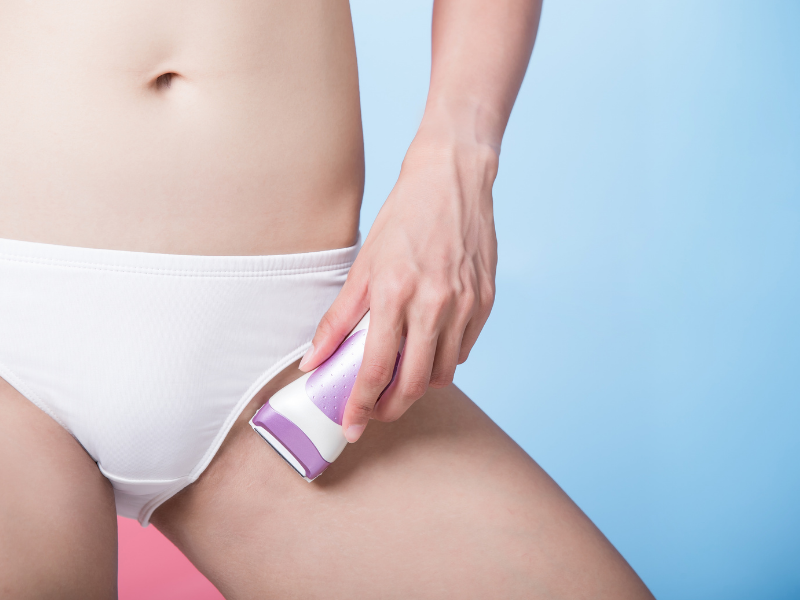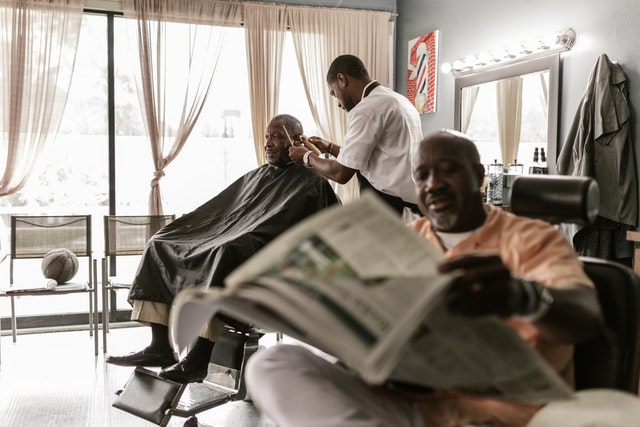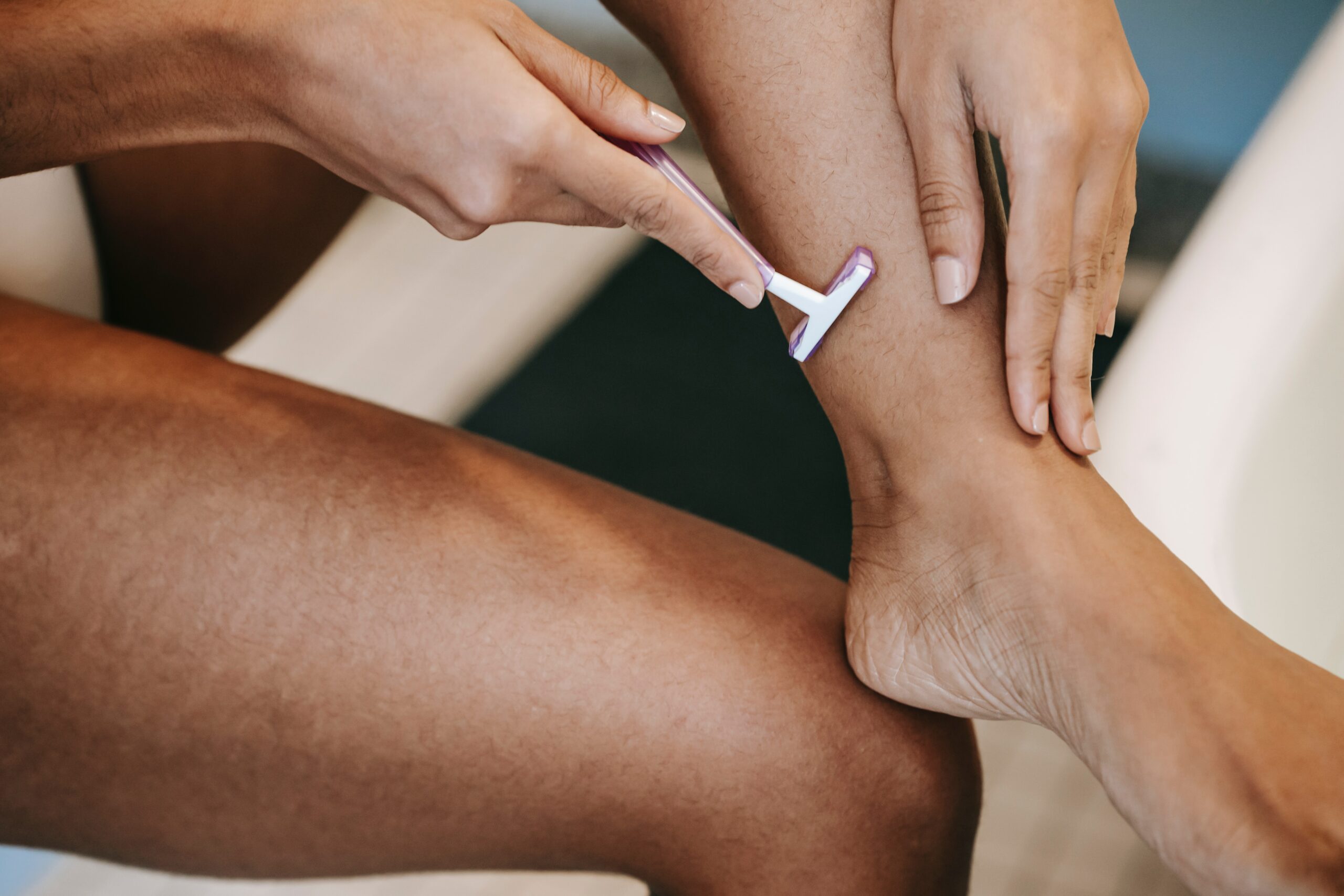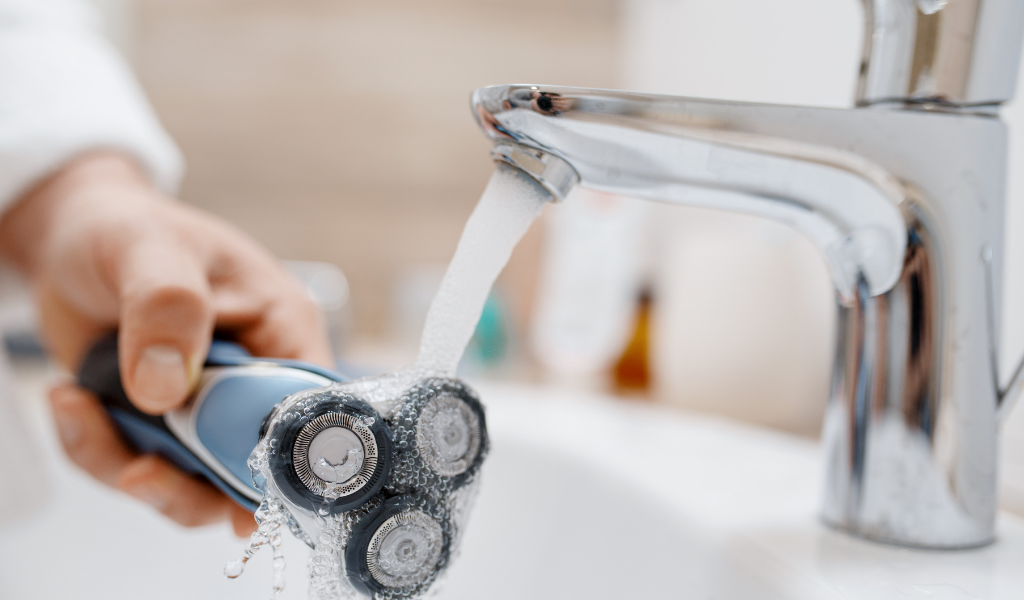You think you’ve just finished shaving your pubic area, but you notice something. It’s red, itchy, and painful. You have a razor bump in your pubic area.
Razor bumps are common for many people who shave the sensitive skin of their genitals, so if you’re dealing with them, don’t beat yourself up about it. If you get a case of razor bumps around the pubic area, you can treat it right away and take steps to prevent future razor bumps.
Here’s how to treat razor bumps in the pubic area once they pop up (and how to prevent them in the first place).

Razor bumps are small, red bumps that can appear after shaving. They’re called “razor bumps” because ingrown hairs from shaving cause them. These bumps develop when hair shafts become trapped beneath the skin’s surface. Ingrown hairs can be painful, itchy, and embarrassing, especially in a sensitive area like your pubic region!
Yes! If you’ve ever shaved or waxed the areas around your genitals, you’re at risk of getting razor bumps. The good news is that if you follow these tips for preventing razor bumps in the future, they’ll be less likely to appear on your body again.
These tips will help keep your skin in good condition and hopefully prevent problems from razor bumps.
If you already notice a red, bumpy rash on your skin, it is too late for prevention. It’s time to focus on treatment.
Make sure to wash the area gently with warm water and soap each day. That will help to cleanse your skin and prevent infection.
Apply a topical cream that soothes razor burn or ingrown hairs, such as aloe vera gel or witch hazel solution.
Apply a warm compress to the affected area for 10 minutes, up to three times per day, to increase blood flow to the area.
If your symptoms don’t go away or become worse, talk to a doctor about other treatments or prescription medications.
If you get razor bumps, treat them right away and take steps to prevent them from coming back.
Razor bumps are no fun, but they’re also nothing to be embarrassed about. Lots of people get them, and you can take steps to prevent them and treat them. Now that you know how razor bumps form and some tips for getting rid of them, give the methods we covered a try!
If you try to relieve razor bumps on your own, but they won’t go away, it’s time to talk to a medical professional.
If razor bumps have you bothered and you want to talk to an online doctor, Razor Bumps, Inc.’s board-certified physicians are available now through easy virtual video visits. Find out more by chatting with us now.
Disclaimer: The contents of this article are for informational purposes only and do not constitute medical advice. The information, graphics, and images on this site are not intended to substitute diagnosis or treatment by a medical professional. Always seek the advice of a licensed physician for any questions you may have regarding a specific condition.
Barbershops are a place for men to sit back and relax. They are also a place for gentlemen to discuss sports, politics, and current events. Going to the barbershop is an experience more than an errand for a haircut or beard trim. Barbers are valued for their skill and expertise in cutting men’s hair. So, can they treat skin conditions caused by shaving?
In general, barbershops do not perform any treatment for skin conditions resulting from shaving. For their safety and the well-being of their customers, barbers cannot work with any open wounds or skin that appears infected. Men with razor bumps should not go to the barbershop for treatment but rather seek medical advice from a licensed physician.
Men who suspect they might have razor bumps can try at-home remedies to ease skin irritation or find a doctor to help. To find out more, read on.

When a customer goes to the barbershop for a shave or trim, the barber will likely ask the client if there are any sensitivities or skin conditions A barber can refuse to shave or cut a person’s hair in some cases. They could turn the client away if the skin shows signs of the following:
Barbers are not licensed to treat skin conditions and are careful not to cause injury. Public health and safety are primary concerns for barbers.
If a man has mild razor bumps on the head or neck, a barber may agree to proceed with the service. Many barbershops apply towels to the face or neck. Warm towels before shaving increase blood circulation to the skin and can soothe irritation. Cool towels after shaving constrict pores and provide a cooling sensation. While both treatments are beneficial for the skin, they are not intended to heal razor bumps.
Men with razor bumps can try at-home remedies to alleviate discomfort and swelling.
Here are some over-the-counter products to try.
Another great do-it-yourself remedy for facial razor bumps is steam treatments. Warm steam on the skin causes pores to open, releasing dead skin cells, dirt, and other debris. Trapped particles in the skin cause pimples and ingrown hairs. In addition, an all-natural steam treatment improves blood flow to the skin, which can help heal compromised skin. Here are steps to try an at-home steam facial.
Consider adding herbs, tea, or essential oils to the boiling water to pamper your skin.
A word of warning, steaming is not recommended for some. Individuals with eczema, for example, can cause skin irritation. If you are unsure if a steam facial is safe for you, ask a doctor.
Individuals can also make an appointment with a doctor’s office or a dermatologist if they have questions about razor bumps.
Thanks to telemedicine, the easiest and fastest way to talk with a doctor about razor bumps is to book an appointment with a virtual physician. Services like Razor Bumps, Inc offer inexpensive, convenient appointments for skin problems for patients who do not have a doctor or cannot get in to see their regular doctor.
Summary
In short, men with razor bumps can try to alleviate skin irritation from razor bumps or find a doctor to help. While barbers are highly skilled at their craft, they are not qualified to treat any skin condition. Razor bump treatment is best left to the professionals.
If you have questions for the Razor Bumps, Inc physicians, don’t wait! Contact us now.
“Code of Ethics”. americanbarber.org. Accessed April 14, 2022.
“Is Steaming Your Face Good for Your Skin?”. health.clevelandclinic.org. Accessed April 14, 2022.
Disclaimer: The contents of this article are for informational purposes only and do not constitute medical advice. The information, graphics, and images on this site are not intended to substitute diagnosis or treatment by a medical professional. Always seek the advice of a licensed physician for any questions you may have regarding a specific condition.
Have you ever noticed a rash on your legs after shaving? If so, it could have been razor bumps. So, what do razor bumps look like on the legs?
Razor bumps on the legs look like small pimples or ingrown hairs. It is important to differentiate between razor bumps and bumps that appear after shaving. Razor bumps is a true medical condition formally known as pseudofolliculitis barbae. Bumps that show up as a rash on the legs after shaving could be something else. What some people refer to as razor bumps, actually aren't.
There are also a few other bumpy skin conditions associated with shaving. Razor bumps are more common in some parts of the body and certain skin types. If you see something that looks like razor bumps, here’s what you need to know.

Shaving often irritates the skin. As a result, it can cause problems, such as razor bumps. Razor bumps on the legs might look pink or red. And they are often swollen.
The medical term for razor bumps is pseudofolliculitis barbae. In particular, it is caused by hairs cut by a razor with a pointy or jagged edge, like a tiny knife. Sometimes, these short, coarse, curly hairs curl and grow back into the skin. In other words, razor bumps are a type of ingrown hair. Only a medical professional licensed to diagnose and treat conditions can tell for sure if it's razor bumps.
Razor bumps usually appear 24-48 hours after shaving. The good news is that razor bumps typically do not appear on the legs. Razor bumps usually cause ingrown hairs on the face and neck for two reasons:
An exception, though, is the upper thigh and groin area. This area is more likely to be affected by true razor bumps. That is because hairs in these regions are likely to be thicker and wavy or curly.
Bumps on the legs after shaving that are not located in the thigh or groin area are probably not razor bumps. They could be another skin condition.
Bumps on the lower legs after shaving might be razor burn. Razor burn is another type of rash that looks like small red bumps. But it is not caused by ingrown hairs. So, it usually shows up in only a few hours after shaving.
Razor burn is usually not as serious as razor bumps and resolves on its own quickly. It is caused by skin irritation related to the razor, shaving products, or just the shaving method. While it causes a burning sensation and looks bad, it usually won’t cause any long-term damage.
Another reason you might have bumps on your legs after shaving is an irritation caused by the razor or the shaving cream. Skin sensitivities can show up as a rash. topics/sensitive-skin" rel="noreferrer noopener">Itching is a good sign that someone might have skin sensitivity.
Folliculitis is another condition that could cause bumps on the legs after shaving. A hair follicle is a pocket in the skin where the hair root grows. Folliculitis is an inflamed, irritated, or infected hair follicle.
Sometimes the skin pocket or hair follicle is injured through shaving. When bacteria enter the hair follicle, it can cause infection.
Folliculitis, skin sensitivities, and razor burn are three conditions that might look like razor bumps. People often refer to them as razor bumps because they cause spots on the skin, usually after shaving. But each condition has a different cause, so they are treated differently.
So how can you tell what the rash on your leg is?
These are four skin problems that commonly appear on the legs. If you noticed bumps from shaving on your legs and are unsure if you have razor bumps or something else, talk to a doctor about it. A virtual physician can look at your skin through a secure video visit and make recommendations to help you treat the problem. They can help you clear up your skin in no time, and you can say goodbye to unattractive bumps on your legs.
Have you experienced problems from shaving for your job? If razor bumps have you worried, you need to talk to one of our doctors. Meet a top board-certified physician online through a convenient virtual video visit. Find out more by chatting with us now.
Disclaimer: The contents of this article are for informational purposes only and do not constitute medical advice. The information, graphics, and images on this site are not intended to substitute diagnosis or treatment by a medical professional. Always seek the advice of a licensed physician for any questions you may have regarding a specific condition.

Day One after shaving, skin feels nice and smooth. So why does Day Three feel bumpy and painful? Is your razor causing the bumps? Well, that is a common question.
Shaving can cause unsightly and bothersome razor bumps. In short, the type of razor and how it is cared for certainly contributes to skin irritation. Hence, changing your razor can reduce razor bumps and improve the skin’s appearance.
To find out which razor you should be using and how to care for it, read on.
Razor bumps is a term that is used to describe the skin irritation that commonly appears 2-3 days after shaving. Men may see this condition on their faces, while women can experience razor bumps from to-avoid-bikini-line-bumps/">shaving the bikini area. Essentially anyone using a razor for hair removal is at risk for razor bumps.
There are many types of razors available today. Each type of razor is different in terms of cost, convenience, and use. Here are some pros and cons of the common types of razors for shaving.
| Type of Razor | Pros | Cons |
| Electric Razor | Faster shave Convenient for on-the-go use Wet or dry | Requires batteries or power More expensive Requires maintenance/cleaning |
| Straight Blade | Lower risk of skin irritation No pulling/tugging at the follicle Better precision | Most expensive The learning curve to use Takes more time to shave and requires products |
| Disposable cartridge, double or triple blade | Easy to use Easy to replace Less expensive Closer shave | Risk of nicks/cuts Replace after 4-5 uses Going over areas repetitively increases skin irritation |
The key to selecting a razor that won't cause bumps is to consider how the razor works.
Most electric razors snip hairs off between multiple rotating blades. Some may pull or tug the hair, which can irritate the follicle. Pulling hairs before cutting also means that blades will release the hairs below the skin's surface. While that can mean a close shave, it can also be a problem. Growing under the surface may lead to ingrown hairs.
Choosing a razor with the least number of blades will help reduce razor bumps too. Disposable razors with two or three blades usually work by catching the hair on the first blade and cutting it off with the second blade. A single-blade and straight razors allow a clean cut without tugging hair or leaving a jagged edge.

Properly caring for a razor can also help prevent razor bumps. Here are some keys to razor care that will help to prevent razor bumps:
No matter what type of razor you choose, keeping it clean and protecting the blades before, during, and after use can help reduce razor bumps.
Now you know how to choose a razor and how to care for it. These two steps can reduce the burden of razor bumps. If you’ve tried changing your razor but still battle razor bumps, it might be time to talk to a doctor. In some cases, razor bumps can be severe, or lead to more serious conditions.
To talk with one of the top board-certified physicians, book an appointment below. Our caring experts can help answer your skin questions.
Disclaimer: The contents of this article are for informational purposes only and do not constitute medical advice. The information, graphics, and images on this site are not intended to substitute diagnosis or treatment by a medical professional. Always seek the advice of a licensed physician for any questions you may have regarding a specific condition.
Tshudy, M. & Cho, S. (2021, January 30) Pseudofolliculitis barbae in the U.S. military, a review. Military Medicine, Volume 186, Issue 1-2. Retrieved from https://doi.org/10.1093/milmed/usaa243
Nussbaum D. & Friedman A. (2019, March) Pseudofolliculitis barbae: A review of current treatment options. Journal of Drugs in Dermatology : JDD, 18(3). Retrieved from https://europepmc.org/article/med/3090932
Eske, J. (2019, July 29). Causes and remedies for itchiness after shaving. Medical News Today. Retrieved from today.com/articles/325886#causes">https://www.medicalnewstoday.com/articles/325886#causes